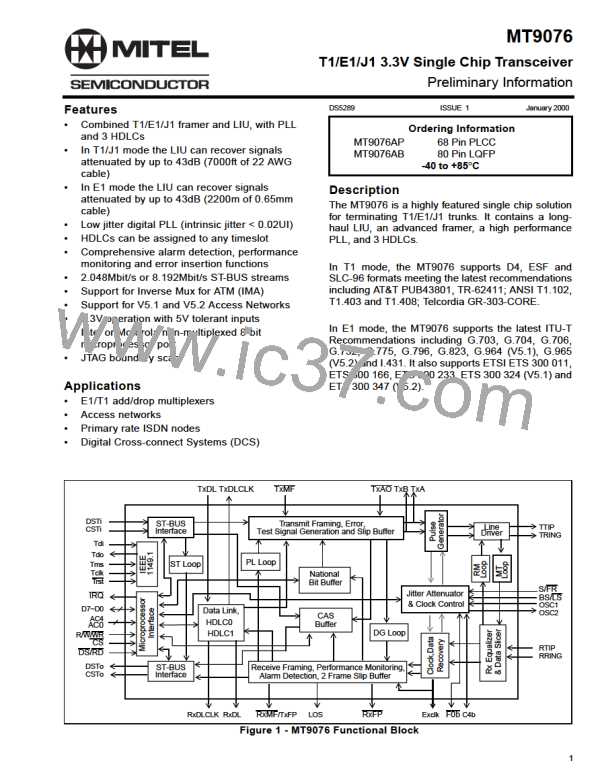Preliminary Information
MT9076
dual byte address is being received. If this bit is 0 then a two byte address is being received and then only the
first six bits of the first address byte are compared. An all call condition is also monitored for the second
address byte; and if received the first address byte is ignored (not compared with mask byte). If the address
extension bit is a 1 then a single byte address is being received. In this case, an all call condition is monitored
for in the first byte as well as the mask byte written to the comparison register and the second byte is ignored.
Seven bits of address comparison can be realized on the first byte if this is a single byte address by setting the
Seven bit of Control Register 2.
The following two Status Register bits (RQ8 and RQ9) are appended to each data byte as it is written to the Rx
FIFO. They indicate that a good packet has been received (good FCS and no frame abort), or a bad packet
with either incorrect FCS or frame abort. The Status and Interrupt Registers should be read before reading the
Rx FIFO since status and interrupt information correspond to the byte at the output of the FIFO (i.e. the byte
about to be read). The Status Register bits are encoded as follows:
RQ9
RQ8
Byte status
1
0
1
0
1
1
0
0
last byte (bad packet)
first byte
last byte (good packet)
packet byte
The end-of-packet-detect (EOPD) interrupt indicates that the last byte written to the Rx FIFO was an EOP byte
(last byte in a packet). The end-of-packet-read (EopR) interrupt indicates that the byte about to be read from
the Rx FIFO is an EOP byte (last byte in a packet). The Status Register should be read to see if the packet is
good or bad before the byte is read.
A minimum size packet has an 8-bit address, an 8-bit control byte, and a 16-bit FCS pattern between the
opening and closing flags (see Section 9.3.2). Thus, the absence of a data transmission error and a frame
length of at least 32 bits results in the receiver writing a valid packet code with the EOP byte into Rx FIFO. The
last 16 bits before the closing flag are regarded as the FCS pattern and will not be transferred to the receiver
FIFO. Only data bytes (Address, Control, Information) are loaded into the Rx FIFO.
In the case of an Rx FIFO overflow, no clocking occurs until a new opening flag is received. In other words, the
remainder of the packet is not clocked into the FIFO. Also, the top byte of the FIFO will not be written over. If
the FIFO is read before the reception of the next packet then reception of that packet will occur. If two
beginning of packet conditions (RQ9=0;RQ8=1) are seen in the FIFO, without an intermediate EOP status,
then overflow occurred for the first packet.
The receiver may be enabled independently of the transmitter. This is done by setting the RXEN bit of Control
Register 1. Enabling happens immediately upon writing to the register. Disabling using RXEN will occur after
the present packet has been completely loaded into the FIFO. Disabling can occur during a packet if no bytes
have been written to the FIFO yet. Disabling will consist of disabling the internal receive clock. The FIFO,
Status, and Interrupt Registers may still be read while the receiver is disabled. Note that the receiver requires a
flag before processing a frame, thus if the receiver is enabled in the middle of an incoming packet it will ignore
that packet and wait for the next complete one.
The receive CRC can be monitored in the Rx CRC Registers. These registers contain the actual CRC sent by
the other transmitter in its original form; that is, MSB first and bits inverted. These registers are updated by
each end of packet (closing flag) received and therefore should be read when an end of packet is received so
that the next packet does not overwrite the registers.
39

 MITEL [ MITEL NETWORKS CORPORATION ]
MITEL [ MITEL NETWORKS CORPORATION ]